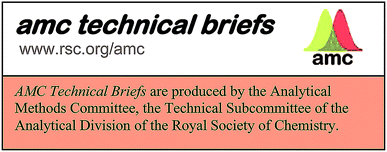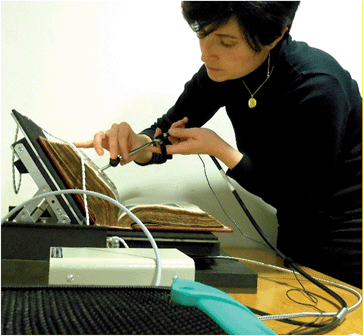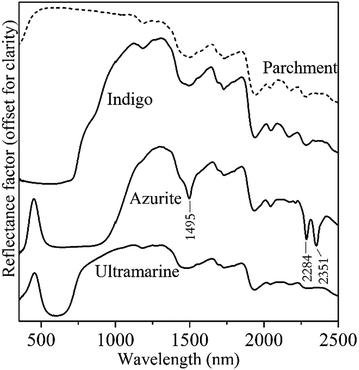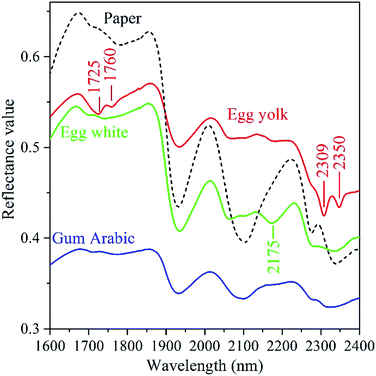UV-visible-NIR reflectance spectrophotometry in cultural heritage: Background paper
Analytical Methods Committee AMCTB No 75
First published on 20th July 2016
Abstract
Diffuse reflectance spectrophotometry in the ultraviolet, visible and near-infrared (UV-vis-NIR) range is becoming a widely-used tool for the non-invasive analysis of cultural heritage objects, especially in its variant with optical fibres, commonly dubbed FORS (Fibre Optic Reflectance Spectroscopy). It is especially useful to study objects such as medieval manuscripts for which sampling is prohibited by current conservation standards. This brief describes the most common types of application of FORS in the analysis of cultural heritage objects; it also illustrates the instrumentation used and the main advantages and limitations of the technique.
Although the application of reflectance spectrophotometry to the study of artworks dates back to the late 1930s, it is only since the late 1970s that this method has been used to monitor colour changes and identify pigments on painted surfaces. During the last 20 years, with the advent of fibre-based instruments, cultural heritage applications of UV-vis-NIR reflectance spectrophotometry have grown rapidly: FORS is quickly becoming one of the most widely used analytical tools for the non-invasive analysis of works of art and the identification of artists' materials.
Sturdy, portable equipment with extended sensitivity in the near-infrared range (up to 2500 nm) has now been adopted by the cultural heritage community and is increasingly preferred to the previously available spectrophotometers, usually limited to the UV and visible range or just beyond (approx. 200 to 1000 nm).
The ability to probe an extended spectral range means that a great deal of information can be gained not only about electronic transitions (such as ligand field and band-to-band effects) but also about vibrational transitions, of which the overtones and combinations can be observed in the NIR range. The availability of this additional knowledge expands the range of artists' materials that can be reliably identified using this method.
What is FORS good for?
The list at the end of this brief shows a selection of published studies reporting on the application of FORS analysis to a variety of cultural heritage materials, including pigments and paint binders in paintings on panel, parchment and wall, as well as canvas and plastics (see Fig. 1).General comments can be made on the suitability of FORS for the study of different types of objects:
Painted surfaces – FORS is especially useful for the identification of blue, green, white and red pigments (see Fig. 2). FORS spectra of most yellow and black pigments are not characteristic enough to allow identification, except at times within a broad category (e.g., iron oxides and hydroxides, or carbon-based pigments). Binding media and varnishes can also be broadly categorized (see Fig. 3), although complications can arise when their spectral features overlap with those of the support, as is the case especially for parchment.
Paper and parchment – these two materials can be easily differentiated when doubts exist, and FORS can be used along with other tools to study their degradation mechanisms.
Textiles – FORS allows distinction between wool, silk, cotton, and bast (e.g., linen or hemp) fibres. This can be useful to identify the exact nature of the support for paintings on canvas, and for the characterization of tapestries as well as historic carpets, costumes and upholstery fabrics.
Plastics – FORS has recently been used to study the degradation of plastic materials used in 20th century artworks and objects. This type of application is likely to become more common in view of the growing interest in the fugitive nature and complex material composition of much contemporary art.
Advantages and limitations
FORS has the advantage of being completely non-invasive and very quick – a good quality spectrum can be obtained in less than 10 seconds, and viewed in real time, allowing for extensive surveys of individual artworks or entire collections in a relatively short time.Fibre-based instruments do not set any limitation to the size and shape of the objects one can analyse using this method. However, the use of optical fibres usually limits the spatial resolution of the analysis to 2–3 mm.
Although FORS is generally considered to be a ‘surface analysis’ technique, best suited for example for the analysis of the outer paint layers, the NIR spectral features usually do give information on the nature of the substrate.
Analysis of spectra
Qualitative interpretation of FORS spectra is relatively easy, although the identification of individual components of complex mixtures can be extremely challenging owing to overlapping of bands and the presence of several absorptions from the same functional group. Mathematical models based on the Kubelka–Munk theory of reflectance can be used to try and separate the contribution of each component to the overall spectrum.Quantitative information may be hard to extract from the spectra, especially when a fixed set-up cannot be used owing to the shape of the object being analysed (for example, a curved surface might have to be compared with a flat standard). Mathematical and statistical methods can be used to further explore the variability of the spectra and improve spectral classification, and consequently the identification of specific materials.
Although modelling of the reflectance spectrum is theoretically possible given enough knowledge of the optical properties of a sample, usually artists' materials are identified with the help of spectral databases, either available in the literature or built in-house to suit the specific requirements of the individual researcher (e.g., pigments painted on paper, canvas or parchment support). Each reference sample is characterized by specific spectral features, such as the position of absorption bands and transition edges, which can be used to identify unknown materials with matching features. Fig. 2 and 3 show examples of reference spectra of different pigment-binder-support combinations which can be distinguished based on their UV-vis-NIR reflectance spectra.
Further reading
• M. Aceto, A. Agostino, G. Fenoglio, A. Idone, M. Gulmini, M. Picollo, P. Ricciardi, J. K. Delaney, Characterisation of colourants on illuminated manuscripts by portable fibre optic UV-visible-NIR reflectance spectrophotometry, Anal. Methods, 2014, 6, 1488–1500, DOI: 10.1039/c3ay41904e.• M. Bacci, Fibre optics applications to works of art, Sensors and Actuators B, 1995, 29, 190–196, DOI: 10.1016/0925-4005(9501682-1).
• A. Cosentino, FORS spectral database of historical pigments in different binders, E-conservation J., 2014, 2, 53–65.
• C. Cucci, L. Bigazzi, M. Picollo, Fibre optic reflectance spectroscopy as a non-invasive tool for investigating plastics degradation in contemporary art collections: a methodological study on an expanded polystyrene artwork, J. Cultural Heritage, 2013, 14, 290–296. DOI: 10.1016/j.culher.2012.08.003.
• M. Oriola et al., Looking beneath Dalí's paint: non-destructive canvas analysis, Anal. Methods, 2014, 6, 86–96. DOI: 10.1039/c3ay41094c.
• P. Ricciardi, J. K. Delaney, M. Facini, L. Glinsman, Use of imaging spectroscopy and in situ analytical methods for the characterization of the materials and techniques of 15th century illuminated manuscripts, J. Amer. Inst. for Conservation, 2013, 52, 13–29, DOI: 10.1179/0197136012Z.0000000004.
• M. Vagnini, C. Miliani, L. Cartechini, P. Rocchi, B. G. Brunetti, A. Sgamellotti, FT-NIR spectroscopy for non-invasive identification of natural polymers and resins in easel paintings, Anal. Bioanal. Chem., 2009, 395, 2107–2118, DOI: 10.1007/s00216-009-3145-6.
Paola Ricciardi (Fitzwilliam Museum, University of Cambridge)
This Technical Brief was prepared by the Heritage Science Subcommittee and approved by the Analytical Methods Committee on 19/06/16.
| This journal is © The Royal Society of Chemistry 2016 |





